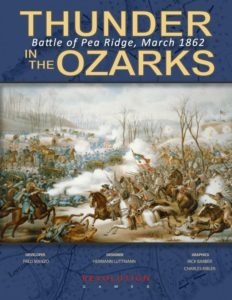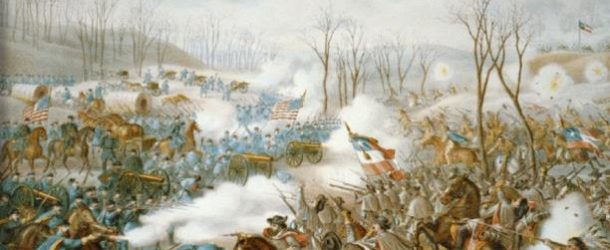By Rob Bottos:
I have owned both Duel of Eagles II and Stonewall’s Sword for the last year but had yet to be able to get them on the table. Both games use Hermann Luttmann’s Blind Swords system. I had heard that this system produced a lot of chaos and was not sure how it would play.
While attending Pacificon in Santa Clara, I was able to sit down with Roger Miller of Revolution Games, and learn the game system from him. We played the Leetown scenario from the forthcoming Thunder in the Ozarks, the next game to use the Blind Swords system.
I’ve played Richard Berg’s GBACW – both from the SPI days, and now GMT. While Berg may have introduced variability activation with his chit pull system, it still lacks something for me as you will always know how many chit pulls/activations a formation will get.
I’ve played lots of Civil War Brigade series, and was a playtester for the Line of Battle series, and while I liked the delays incorporated via the orders system, once accepted you still had absolute control over your various units.

“Thunder in the Ozarks: the Battle of Pea Ridge” is scheduled to be published in late October by Revolution Games. Hermann Luttmann is its designer, I’m its developer and Rick Barber is its artist. The game itself comes with four scenarios: the Battle of Leetown, the Battle of Elkhorn Tavern, the historical campaign scenario and a hypothetical campaign scenario. The first two scenarios are on one map. The counters are done, the rules are in final playtesting and the final version of the map is almost complete. – Fred
No system till now has found a way to simulate the chaos and unpredictability of the battlefield and I think in Blind Swords Hermann has hit upon the right balance. Some have stated that they find Hermann’s system too chaotic, but in all my readings of battles in the Civil War, battles were just that, chaotic. Even when a commander accepted orders, there was no guarantee all his troops would go in, or that his brigades would fight as a single formation. Look at Longstreet’s attack on the Devil’s Den, or Anderson’s assault on Cemetery Ridge on Day 2 for examples.
Just because your activation chit is pulled, you still need to make an activation roll, and your opponent may have a chit which throws some chaos or hesitation into the mix.
Granted I have only played one scenario from Thunder in the Ozarks, but this system “feels” right.
The command and control rules make sense, and it’s not a question of counting command radi. Brigades quite often fragmented in battle, but as long as parent units were there to support each other, morale was not affected. This system does not force you to keep your regiments together, but it will reward you when you do.
So far the three games using this system have a very nice footprint, which for me is important as gaming space is limited. While Thunder in the Ozarks will include 2 maps, it has single map scenarios.
For larger battles using this system, All are Brothers Solferino 1859 is on Legion Wargames CPO and currently sits at 111 orders. At Any Cost Metz, and Hammerin Sickles are both on pre-order at GMT, and while they have surpassed their p500 numbers, they appear to be stalled in development.
In my opinion, Revolution Games has done the heavy lifting here, in terms of making sure the rules work. For GMT it should just be a matter of making sure the scenarios get playtested, the components properly proofread, and some awesome graphics. GMT is sitting on a hot commodity here, and they would be loathe to tinker with it.
I will say that while I have always loved looking at Rick Barber’s maps, I have found them difficult to play on, as I think they should be framed and displayed as artwork on a wall, but this too can be worked out.
I now have Thunder in the Ozarks on order, and am motivated to play Stonewall’s Sword, and Duel of Eagles II. If you like a little chaos in your battles, consider checking out this game and series.
 Thunder in the Ozarks BGG page
Thunder in the Ozarks BGG page








